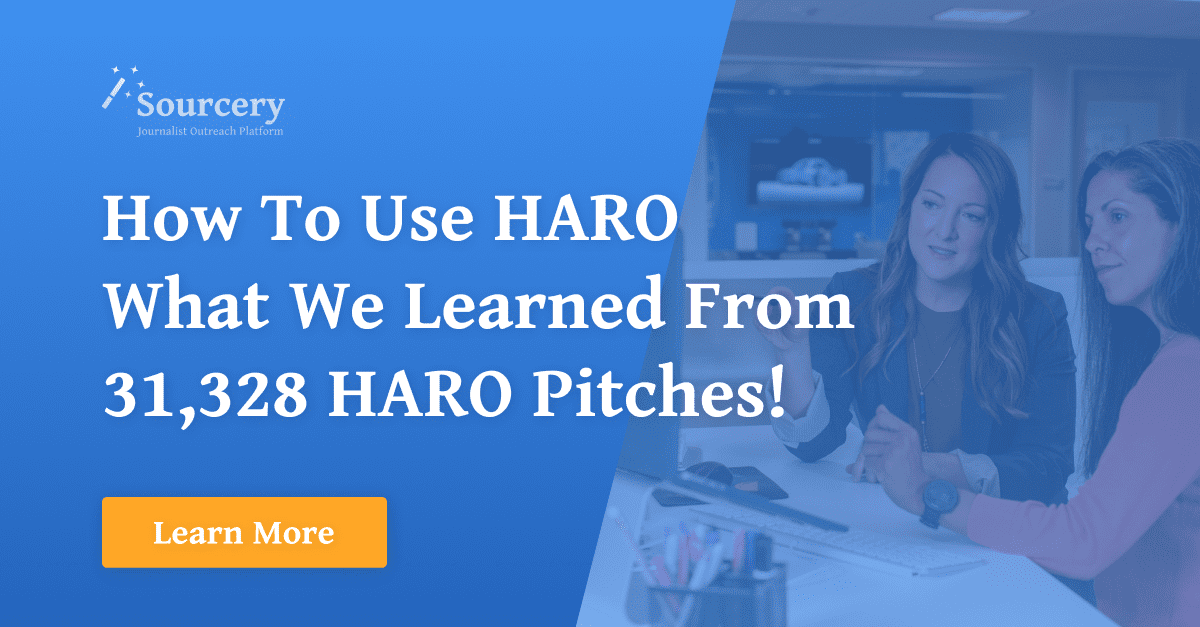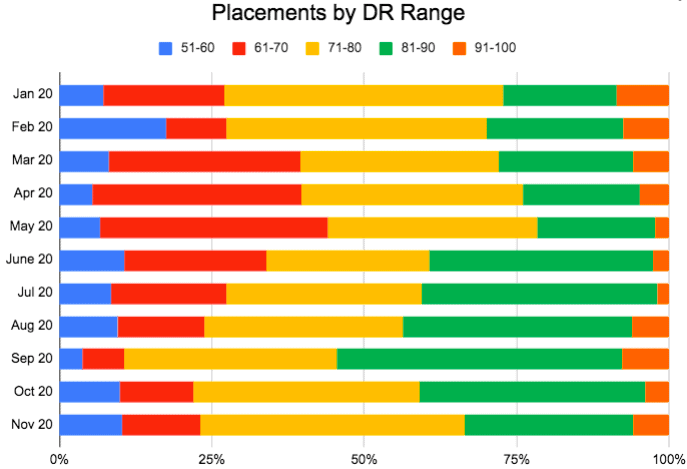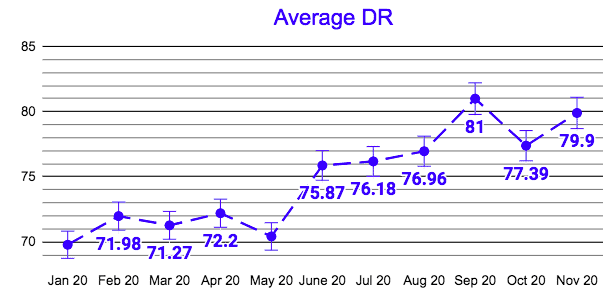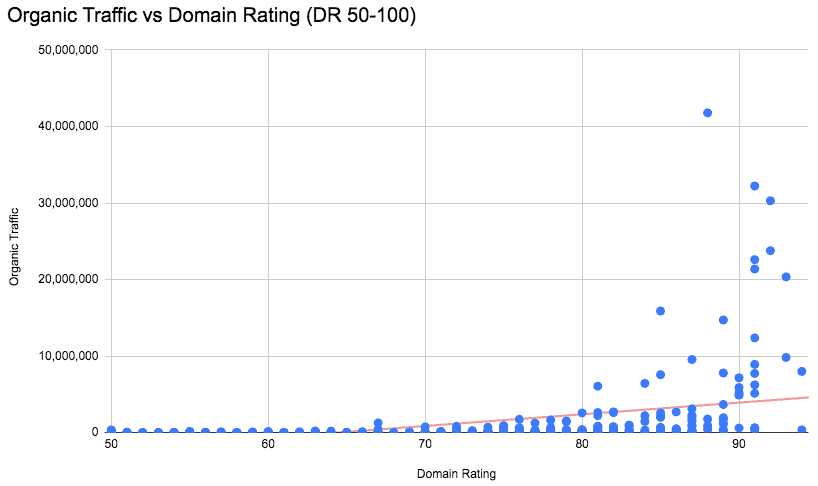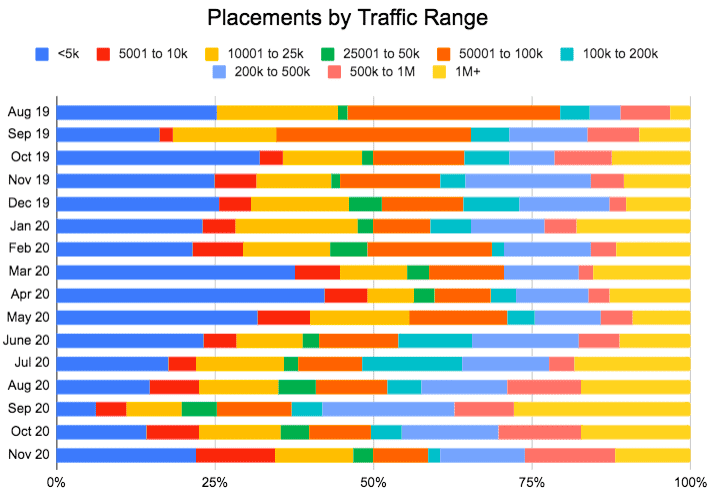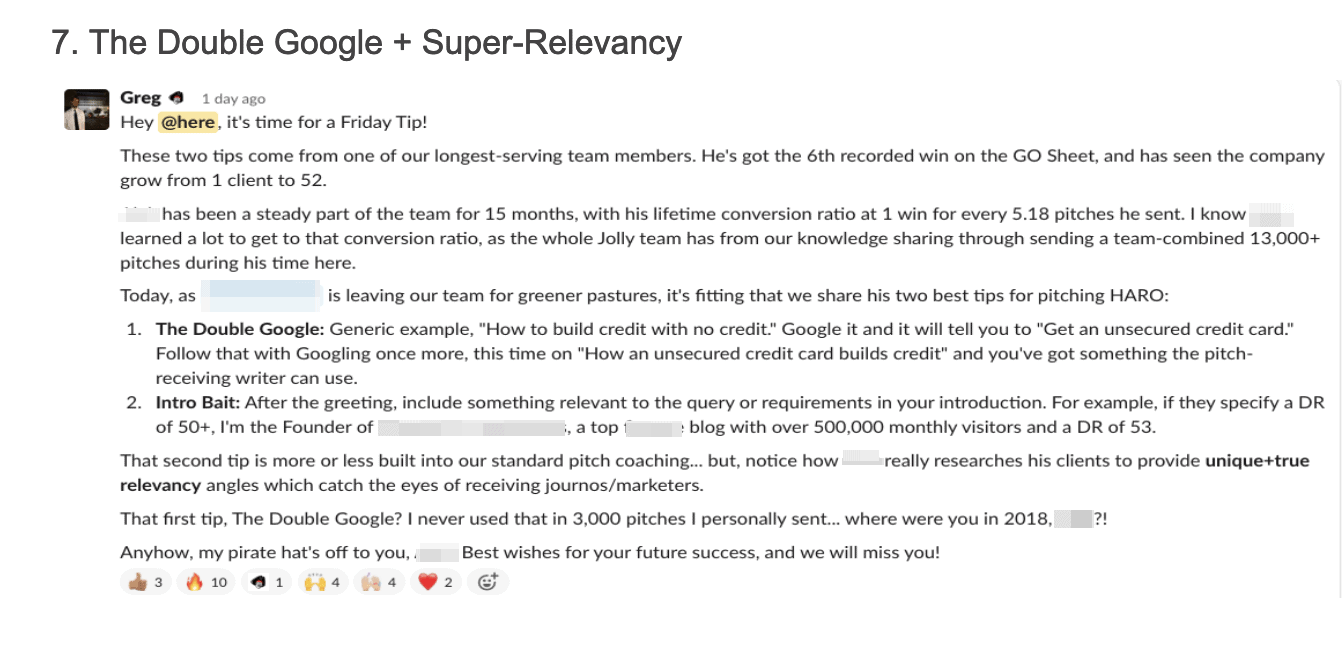Most people will never wake up and say, “I think I’ll create a brand new piece of SaaS today!”
That is, unless you’re like us, with a business model dedicated to earning clients media placements with HARO.
In which case, you may wake up and think, “Damn. I think I can make HARO better.”
How to use HARO: What We Learned from 31,328 HARO Pitches
We had a similar thought. And we couldn’t get it out of our heads. So we built a tool that makes HARO useful for SEOs, marketers, and anybody else interested in getting their company into the media.
In this article, we’re going to lay out the pros and cons of HARO, a 100% white hat link- and authority-building platform. We’ll also show you the kinds of results you can get through HARO by highlighting what we’ve learned over the last two years. Then, we’re going to reveal how we removed as much friction as possible while sending 4,000+ media pitches per month using the service. Over the past 24 months, we’ve:
- Vetted 3,738 domains
- Sent 31,328 pitches
- Built 2,600 links averaging DR 79.9
We hope you can learn from our experience with HARO and add it to your marketing & SEO tactics.

A quick recap: What exactly is HARO?
HARO, which stands for “Help A Reporter Out,” holds a special place in the marketing mix. Owned by Cision, a Chicago-based global media intelligence company, the sole purpose of HARO is to connect journalists with relevant media resources.
Every day, journalists submit requests for commentary—called “queries”—to the service. HARO then sends those queries via email to a huge list of people with various experiences. These sources, as they are called, can quickly scan the list from the HARO email and respond to a journalist’s queries.
It’s brilliant. There’s nothing else quite like it out there. Journalists of all types use HARO, from small, independent blogs to publications like Forbes, the Wall Street Journal, The New York Times, and even TV and podcast hosts. HARO sends out over 50,000 queries each year—an average of 136 new queries per day—which makes it a massive opportunity for individuals to reach relevant journalists.

Why should HARO be a part of your marketing strategy?
HARO is an enormous opportunity for several reasons. In the last few years, we’ve come to see it as an underutilized resource for SEO, authority, and PR purposes.
HARO is an amazing way to get backlinks to your website
Any SEO strategist out there will tell you—backlinks are an essential part of your SEO strategy.
But not just any backlink will do. The goal is to get links from sites trusted by Google: sites that have high domain ratings (DR) and high traffic.
A backlink from an authoritative site is a signal to Google that your website is trustworthy. Moz calls a backlink a “vote of confidence” from one site to another.
Say you’re a boutique furniture maker. You notice that Apartment Therapy has a HARO query asking furniture makers to pitch their products for a new style guide. You send in a pitch with a table you make. The editor loves it and features it in the guide.
Apartment Therapy has a DR of 87. If this style guide includes a dofollow link to your website, it’s a sign that Apartment Therapy trusts your website. Google will notice this, and some of Apartment Therapy’s high-trust link juice will trickle down to your own site.
But DR isn’t enough. The referring site also needs to have high traffic.
When it comes to defining exactly what Google looks at when it ranks domains, the SEO community agrees on one thing: traffic is a significant factor.
We ran a poll in the leading SEO groups on Facebook and in private mastermind groups. We asked these groups:
If you had to pick two of these metrics to evaluate given domains for, which two would you choose?
Respondents could select organic traffic, DR, relevance, TF/CF, or DA as their top two options.
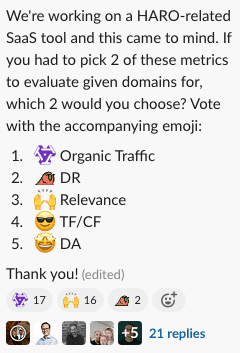
The Traffic Think Tank community’s #LinkBuilding channel was a close race, but organic traffic still won with 17 votes.
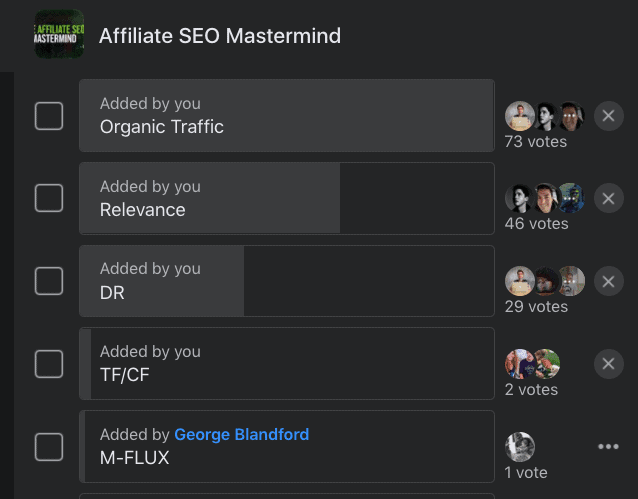
In Matt Diggity’s Affiliate SEO Mastermind group, the referring domain’s organic traffic was by far the most important metric to assess a link. Organic traffic received 73 votes, while the runner-up of relevance only received 46 votes.
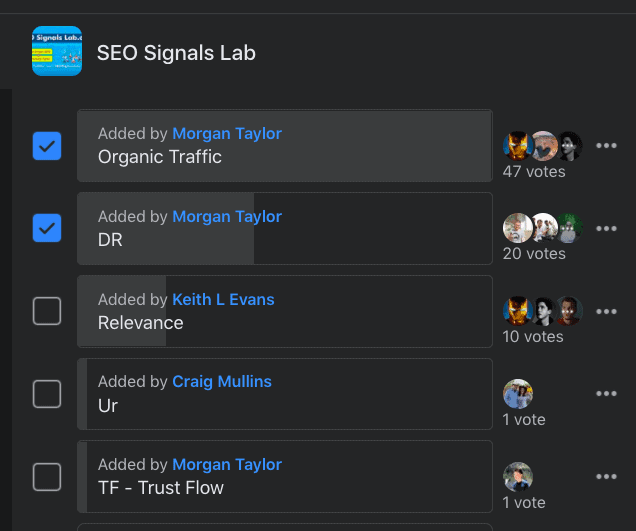
The SEO Signals Lab voted organic traffic over DR by almost 2.5:1. Organic traffic won at 47 votes, and DR came in second with 20 votes.
Again, there’s no way to know for sure how important traffic is. But it is a logical indication of the trustworthiness of a website. If a site has high traffic, it likely means more people trust that site’s content, which signals to Google that the site is worth ranking. The New York Times and a small blog about tools will have two totally different traffic rates—and the NYT will always rank higher.
HARO helps you build authority in your industry
In 2018, there was a major update to Google’s SEO. The update became known as the “medic update” after many online health sites suddenly saw organic rankings drop overnight.
Why? Because Google started to care about an author’s expertise, authority, and trustworthiness (better known as E-A-T) on a subject.
Pre-medic update, some of the top-ranking health articles were written by people who had no medical qualifications. They’re not subject matter experts. This posed an obvious problem because the only people we should go to for health expert advice are certified doctors and health practitioners (also known as the people who are qualified to give medical advice).
Google saw this problem too. And when it updated the search algorithm in 2018, it appeared to stop prioritizing articles written by unqualified professionals. That’s why health sites saw organic traffic drop so suddenly.
Since then, authority building has been a part of any good SEO strategy.
So how do you go about building authority online? The answer is deceptively simple: show Google you know what you’re talking about. You can do this through guest posts, backlinks, and high-quality content across the Internet.
Now, you have to think about your entire presence online, from your LinkedIn account to your Twitter. But HARO is another way to build authority on a subject matter within the larger online ecosystem.
If you can get relevant dofollow backlinks to your website or your LinkedIn profile, search engines will notice. If you do this enough, Google will start to see you as an expert in the field.
As a result, any content you produce (or at least produced under your name) will begin climbing in search engine rankings.
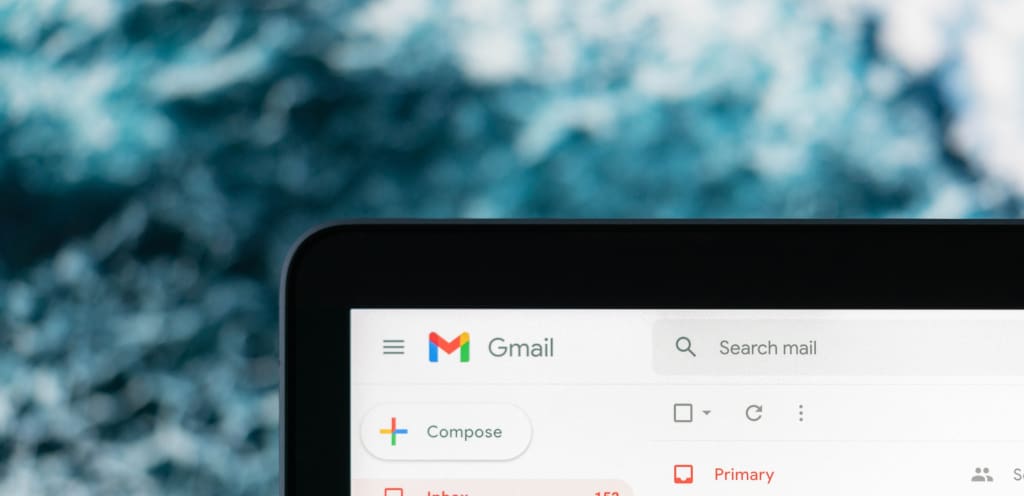
HARO has PR value
Don’t get me wrong: public relations is an industry built completely on relationships. Great PR professionals have lots of contacts within the world of journalism, and they’ll be able to help you organize a launch, gain coordinated media attention, and maximize and respond to any media coverage you earn.
But, good PR is a big investment. If you don’t want to launch a sophisticated campaign, a PR agency may not make sense.
If you want to earn backlinks from established outlets without the full PR treatment, HARO is a good place to start. HARO is a great way to put your name in front of millions of readers, raise brand awareness, and earn media badges for your website—without investing in a PR team and distributing a press release.
Now, HARO won’t replace traditional PR, especially if you want to launch something big or gain a lot of impressions in a short period of time. But it’s a great, lean way to earn some media attention and help a reporter.

What kinds of results can you get by pitching to HARO?
Before Sourcery, there was Jolly SEO’s Done-For-You HARO service. We launched this service in 2019, and we’re still growing it today. Our team of 35+ writers has helped over 100 clients secure 2,600+ high DR dofollow backlinks.
All using HARO as a source.
If you know anything about guest post-based link building for brand exposure, the average DRs are in the 20-60 range. Or, if you’re targeting the cream of the crop, prices are in the thousands per link. You’ll also have to research a journalist’s contact information.
HARO is a 100% free platform. And you can zero in your targeting as much as you want (especially if you use Sourcery, but more on that later).
Through Jolly, we have learned a ton about HARO, from how to send better pitches to subject lines that work to which websites offered dofollow links. We’ve learned some strategies that allowed us to answer query requirements the best way possible. We saw our team earning links on some of the highest DR sites out there.
As we got better at HARO, we realized that the platform is even more powerful than we originally thought. And we had the numbers to prove it.

Domain Rating
We mentioned that there are high DR queries on HARO. But how big is the opportunity, really?
Quite big, actually.
At Jolly, we focus on high DR wins, which means we almost exclusively send HARO pitches to DR 50+ queries. Most of our efforts go toward DR 70+ queries.
We’ve found that there’s no shortage of relevant queries from these sources. Our team currently sends out 4,000+ pitches per month, and we win 275-300 placements every month. The average DR of these wins is currently 79.9—which signals a healthy supply of high DR opportunities.
After years of study, we feel like we’re on the downhill, with energy to spare to share our learnings. It hasn’t always been easy.
HARO, like any other endeavor, has a learning curve. As we’ve grown and optimized our pitching process, the average DR of our wins has risen. In January 2020, our average DR was 69.8. In November 2020, our wins averaged DR 79.9.
We’ve learned through trial and error that there are DR 90+ queries on HARO, and you can win them. If you do some digging and sorting through the HARO newsletter, you’ll find queries from outlets like the New York Times, The Wall Street Journal, Forbes, and more.
Protecting link juice (unlinked mentions & rel=nofollow)
One thing we’ve learned about those sites at the top of the SEO pyramid is that it’s hard to get links from them.
Part of the reason companies like The New York Times and The Wall Street Journal stay at the top is because they are considered trustworthy sources. But another reason they are at the top is that they are masters of SEO.
One small part of that is being guarded with their “link juice”—the amount of power that their website has that seeps through their links. The highest authority sites don’t always give out links because they want to protect their own SERP ranking.
Traffic
DR isn’t the only influencing factor a backlink’s value. The referring site’s traffic is also immensely important for search engine optimization and building authority.
Jolly keeps track of every media outlet placement we make, and we analyzed the traffic of each of the websites we’ve landed on. The graph below is an analysis of Jolly wins, with total traffic on the Y-axis and DR on the X-axis.
As you can see, the higher DR sites also have higher traffic—making them even more valuable for SEO.
You can also see a different view of the traffic of Jolly’s placements in the graphic below, which shows our placement history by traffic range.
The math makes sense
When you look at the numbers, it’s obvious that HARO works. And it works well. At Jolly, we secured 2,100 links on 362 different websites over a 2-year period. But, it hasn’t been easy.
We’ve found that if you don’t care about the DR of the referring site or whether that site provides a dofollow backlink, you’ll likely get one link for every 6-8 pitches you send.
But if you do care about getting links from high DR sites that give a dofollow backlink, the conversion rate is closer to one link for every 8-15 pitches. As you gain experience, that number will improve. Our experienced writers land one in every 4-10 pitches.

Why aren’t more marketers using HARO?
So we’ve convinced you of the power of HARO. Now you might be wondering why it isn’t a common part of any small business’ marketing stack.
The answer is the design of HARO emails!
If you’ve ever opened up HARO emails, you’ll know that they’re a pretty low-tech setup. A simple email with little styling, every newsletter from HARO is long.
HARO emails are a little clunky to navigate. There may be a hundred queries in the email, but there’s no easy way to sort through them—and they lack a lot of crucial information that makes the service useful for marketing.
No DR or traffic information
HARO is a great resource for connecting with journalists. But it lacks a lot of the practical information that users need—like domain rating and traffic details.
If you want to limit your pitches to high-DR publications, you have to do the research yourself. That means checking the authority for every website you pitch to with an SEO engine like Ahrefs or Moz.
No information on nofollows vs. dofollows
Getting your name in the media is (usually) good for business. But if you’re using HARO for SEO purposes, your goal is to get dofollow links from reputable domains.
Unfortunately, HARO doesn’t tell you which websites provide a dofollow backlink and which sites provide a nofollow (or don’t give a link at all). This is something you have to look up for yourself. We’ve learned over time which websites give nofollows, but we only learned this the hard way.

It takes a lot of time
Finally, there are the pitches themselves. In principle, HARO is easy—just email the address associated with a query and voila: you should end up in a publication with a backlink.
The reality though is that these HARO pitches take time to write. We’ve learned over time that the average pitch—which is just 2-4 short paragraphs—takes a writer 10-15 minutes to write.
You also can’t just send one HARO pitch and be done. You have a lot of competition on HARO, so you need to send a lot of pitches. At Jolly, we have a full team dedicated to this, and our average conversion rate is somewhere around one win for every 8-15 pitches.
(Now, we could increase that conversion rate by only going for low-DR wins. But since we offer this as a service, our goal is to get great wins for our customers.)
So if you wanted to land one pitch a week, you’d have to send about 15 pitches. Even at 15 minutes a pitch, that’ll cost 2.5 hours of your time.
Some aspects of HARO are impractical
It’s obvious that HARO has some amazing potential, and many people have had great success with the platform.
But for most of us, the labor-intensive nature of HARO makes it hard to see the benefits.
If you’re strapped for time (and any small business is), the amount of time spent sorting through the queries and finding high-quality publications isn’t worth the link. Especially if you still have to search for the DR, backlinks, and no-follows yourself. And it’s a lot of work to build an efficient process. We know—we’ve built a team of 30 writers around this entire proposition.
There had to be a better way
When we built Jolly’s ghostwriting service, we had to build a system that streamlined HARO.
One early solution we built for our writers was on Airtable. Whenever a newsletter was sent out, we had two people on our team sort through the queries, identify the ones that were in our target DR range, and add the details to a template in our Airtable system.
Over time, we learned which websites added dofollow links and which didn’t. We learned which websites gave credit to our clients for providing input. We also learned which sites to steer clear of because you won’t get quality backlinks.
As we figured out a system that worked, we began to wonder if we could make it easier for everyone to use HARO.
And that’s exactly what we did.

Enter Sourcery
In 2020, we took all of our knowledge about HARO and packaged it together into a software called Sourcery. We beta tested the platform with our team of 30 writers. Then, we opened it up to the rest of the world.
Today, Sourcery isn’t just used by Jolly. As the leading platform for HARO pitching, and it makes HARO a viable option for SEOs, marketers, and CEOs of small businesses. It’s easy to use, thoroughly tested, and totally streamlined to make it easy for you to find the most relevant pitches for you.
How it works
HARO and ProfNet queries get published multiple times per weekday via a newsletter. As soon as the HARO emails go out, we have a human on the backend sort through each of the queries and put them into Sourcery. The queries then appear in one clean dashboard within Sourcery.
The Sourcery dashboard doesn’t just make it easier to navigate HARO queries. It also improves queries with a lot of useful data. Humans on our side input:
- “Known link status”: whether a website offers dofollow or nofollow links, or simply unlinked mentions
- This critical information is updated 3x daily through Jolly’s 4,000+ pitches/month & Sourcery user input
- Query deadline: the system automatically deletes queries that are past the deadline
- Ahrefs Domain Rating
- Estimated organic monthly traffic
Filter by keyword, DR, and traffic range
Another thing we incorporated into Sourcery is the ability to filter queries so you don’t have to sort through items that aren’t relevant for your business or strategy. You can use keywords, DR, and traffic range to find the best journalists requests for you.
Send pitches straight from Sourcery
Pre-Sourcery, you had to copy and paste a query email address into a draft email in your inbox. Now you can make a few clicks and the query is off to the journalist.
Once you’ve found a HARO query topic in Sourcery that you want to respond to, all you have to do is click “Create Pitch.” A window will pop up that lets you quickly write and send the pitch to the journalist.
Sourcery connects to your email server so you can send pitches directly from the platform, then see replies in your email inbox. We won’t ever pull in data from your email—the connection is just to make it easy for you to manage replies from journalists in your main inbox.

Get all of our knowledge about HARO
Sourcery is a great tool because it makes HARO usable. But in our opinion, the best part about Sourcery is the knowledge that comes with the platform.
Inside Sourcery, there is a ton of video content from Jolly’s coaching team about how to successfully pitch to journalists with HARO. It’s the knowledge that we’ve gained and used to train our own team and win over 2,000 placements. And we’re giving it away for free with your subscription. We regularly update the content as our team discovers more tips, tricks, and best practices.
Get backlinks delivered to you
Another perk of HARO is that you don’t need to search for backlinks. We pay link hunters to find wins for every active Sourcery user. You’ll get a notification whenever we find a link that mentions your company name—all you have to do is share the article on your social channels.

Say hello to a new way to do backlinks
We started Jolly because we believed that there was untapped power on HARO. And we started Sourcery because we saw firsthand the results that untapped power could bring. Sourcery fundamentally changes the way marketers and SEOs interact with HARO and makes it a clean, easy experience.
We hope you enjoy Sourcery—we know it has changed our work for the better.

